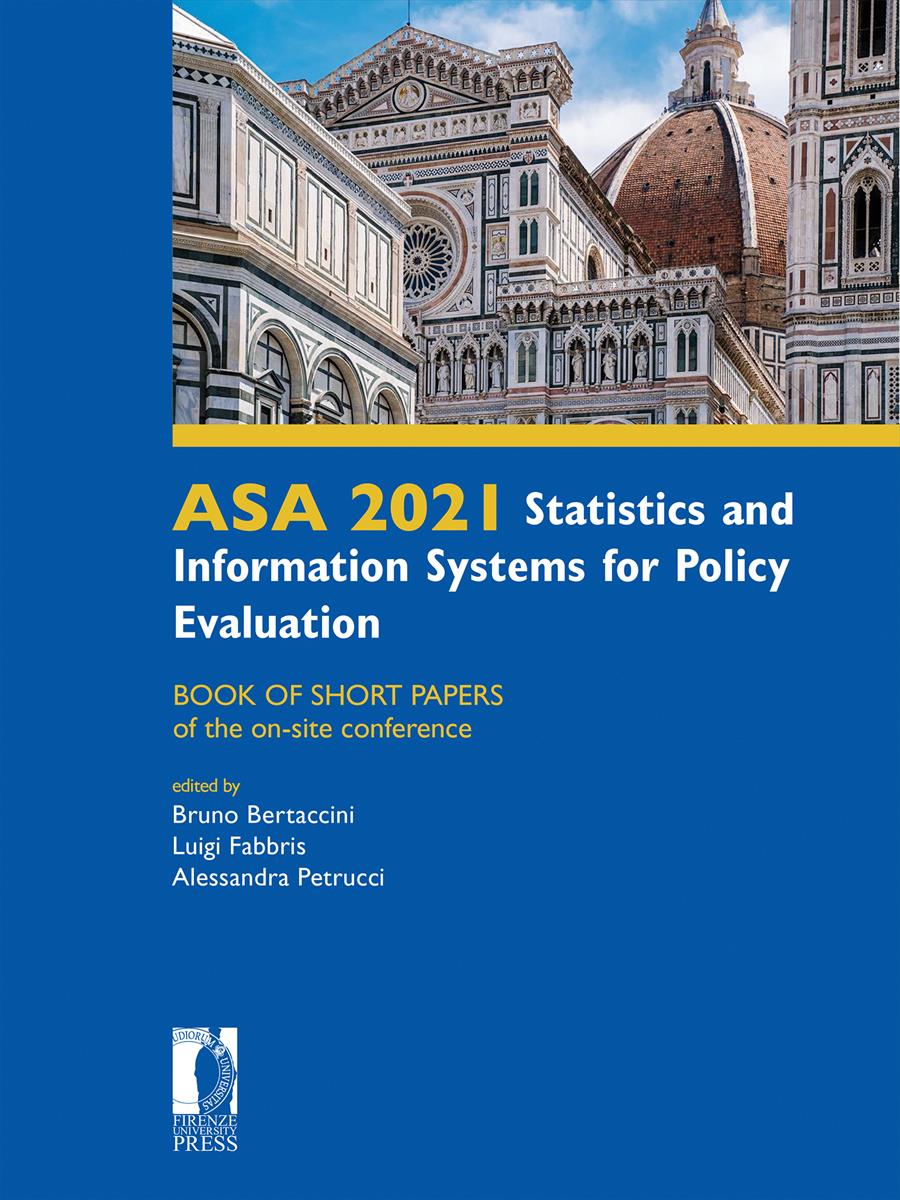- ASA 2021 Statistics and Information Systems for Policy Evaluation
- Edited by Bruno Bertaccini, Luigi Fabbris, Alessandra Petrucci
Reducing inconsistency in AHP by combining Delphi and Nudge theory and network analysis of the judgements: an application to future scenarios
- Simone Di Zio
- © 2021 Author(s) |
- CC BY 4.0
- DOI: 10.36253/978-88-5518-461-8.17
The Analytic Hierarchy Process (AHP) is a Multi-Criteria method in which a number of decision factors (typically criteria and alternatives) are compared pairwise by one or more experts, using the Saaty scale, with the goal of sorting the alternatives (Saaty, 1977; 1980). For group AHP the Delphi method can be used in parallel with the AHP (Di Zio and Maretti, 2014), and this allows the search for a consensus on each pairwise judgement. A big issue of the AHP regards the inconsistency of the pairwise comparison matrices and here we propose a new method to reduce the inconsistency. As a solution we exploit the Nudge theory (Thaler and Sunstein, 2008) and from the second round of the Delphi survey, we calculate and circulate a Nudge to “gentle push” the experts towards more consistent evaluations. Furthermore, we propose the representation of the AHP matrices through graphs. In a direct graph two nodes are linked with two direct and weighted edges (or one edge with the direction based on the weights), where the weights indicate the evaluation given by an expert or, for a group, the geometric mean of the judgements. This type of visualization facilitates the reading of the results and could also be used as real-time feedback in the Delphi process, by displaying on the edges also a measure of variability. An application is proposed, on the evaluation of four future scenarios on the regulation of genetic modification experiments, assessed by a panel of 27 experts according to different criteria (plausibility, consistency and simplicity). The application demonstrated that it is possible to: a) reduce the inconsistency; b) collect useful textual material which enrich the AHP itself; c) use the inconsistency index as a stopping criterion for the Delphi rounds; d) display the pairwise comparison matrices with graphs.
- Keywords:
- Analytic Hierarchy Process,
- Delphi,
- Nudge theory,
- Inconsistency,
- Graphs,
University of Chieti-Pescara G. D'Annunzio, Italy - ORCID: 0000-0002-9139-1451
- Bonaccorsi, A., Apreda R., Fantoni, G. (2020). Expert biases in technology foresight. Why they are a problem and how to mitigate them. Technological Forecasting & Social Change, 151, pp. 1-17.
- Brunelli, N. (2018). A survey of inconsistency indices for pairwise comparisons. International Journal of General Systems, 47(8), pp. 751-771.
- Dalkey,N.C., Helmer,O. (1963). An Experimental Application of Delphi Method to the Use of Experts. Management Science, 9, pp. 458-467.
- Di Zio,S., Maretti,M. (2014).Acceptability of energy sources using an integration of the Delphi method and the analytic hierarchy process.Quality & Quantity, 47(6), pp. 2973–2991.
- Gordon, T.J., Glenn, J.C. (2018). Interactive Scenarios, in Innovative Research Methodologies in Management, Volume II: Futures, Biometrics and Neuroscience Research, eds. L. Moutinho and M. Sokele, Palgrave Macmillan, London (UK).
- Kyu-Min, L., Byungjoon,M., Kwang-Il,G. (2015). Towards real-world complexity: an introduction to multiplex networks. European Physical Journal B, 88(2), pp. 1-20.
- Lai, V.S., Wong, B.K., Cheung, W. (2002). Group decision making in a multiple criteria environment: A case using the AHP in software selection. European Journal Operational Res., 137, pp. 134-144.
- Liao, C.N., (2010). Supplier selection project using an integrated Delphi, AHP and Taguchi loss function. ProbStat Forum, 3, pp. 118-134.
- Linstone, H.A., Turoff M. (2011). Delphi: A brief look backward and forward. Technological Forecasting & Social Change, 78(9), pp. 1712-1719.
- Ossadnik,W., Schinke, S., Kaspar,R.H. (2016).Group Aggregation Techniques for Analytic Hierarchy Process and Analytic Network Process: A Comparative Analysis. Group Dec. and Negotiation, 25, pp. 421-457.
- Pill, J. (1971). The Delphi method: Substance, context, a critique and an annotated bibliography. Socio-Economic Planning Sciences, 5(1), pp. 57-71.
- Pirdashti, M., Omidi M., Pirdashti H., Hassim M.H. (2011). An AHP-Delphi Multi-Criteria Decision Making Model with Application to Environmental Decision-Making. Iranian Journal of Chemical Engineering, 8(2), pp. 3-17.
- Rowe, G. and Wright, G. (1999). The Delphi technique as a forecasting tool: issues and analysis, International Journal of Forecasting, 15(4), pp. 353-375.
- Saaty, T.L. (1980). The Analytic Hierarchy Process. McGraw-Hill, New York (NY).
- Tavana, M., Kennedy, D.T., Rappaport, J., Ugras, Y.J. (1993). An AHP-Delphi Group Decision Support System applied to conflict resolution in hiring decisions. Journal of Management Systems, 5(1), pp. 49-74.
- Thaler, R. and Sunstein, C.R. (2008). Nudge. Improving decisions about health, wealth and happiness. Yale University Press, New Haven (CT).
- Wu,W.H., Chiang,C.T., Lin,C.T. (2008).Comparing the aggregation methods in the analytic hierarchy process when uniform distribution. Transactions on Business and Economics, 3(5), pp. 82-87.
Chapter Information
Chapter Title
Reducing inconsistency in AHP by combining Delphi and Nudge theory and network analysis of the judgements: an application to future scenarios
Authors
Simone Di Zio
Language
English
DOI
10.36253/978-88-5518-461-8.17
Peer Reviewed
Publication Year
2021
Copyright Information
© 2021 Author(s)
Content License
Metadata License
Bibliographic Information
Book Title
ASA 2021 Statistics and Information Systems for Policy Evaluation
Book Subtitle
BOOK OF SHORT PAPERS of the on-site conference
Editors
Bruno Bertaccini, Luigi Fabbris, Alessandra Petrucci
Peer Reviewed
Publication Year
2021
Copyright Information
© 2021 Author(s)
Content License
Metadata License
Publisher Name
Firenze University Press
DOI
10.36253/978-88-5518-461-8
eISBN (pdf)
978-88-5518-461-8
eISBN (xml)
978-88-5518-462-5
Series Title
Proceedings e report
Series ISSN
2704-601X
Series E-ISSN
2704-5846
